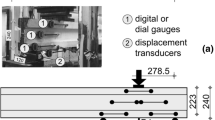Abstract
Increasing the use of metallic-fibre reinforced concrete (MFRC) in structures is related to the definition of analytic methods. In choosing a pertinent kinematic mechanism, the principles deduced from reinforced concrete analysis may be applied to these materials, provided that the material behaviour has been determined. Thus, a model of the bending behaviour of beams is proposed based on the equilibrium of forces in a cracked section. This approach explicitly takes into account the crack opening. To provide an adequate material behaviour, a uniaxial tensile test is presented. It gives a Force-Crack Opening relationship. Samples are cored in the beams to represent thein-situ material. Calculations are compared with experimental data. These tests were performed using three types of fibres and two beam sizes. An extension of the approach to combined flexure and axial load is compared with data appearing from the literature.
Résumé
Le développement de l'utilisation des bétons renforcés de fibres métalliques dans les structures est lié à la définition de méthodes de calcul. À partir d'un mécanisme cinématique pertinent, les principes utilisés pour le calcul de structures en béton armé peuvent être adaptés à ces matériaux, à condition de déterminer correctement leur comportement. On propose ainsi une modélisation de poutres, soumises à une flexion, basée sur l'équilibre d'une section fissurée. Ce modèle prend explicitement en compte l'ouverture de fissure. Un essai de traction uniaxiale est utilisé pour déterminer le comportement du matériau. Il fournit une relation effort-ouverture de fissure. Les éprouvettes sont carottées dans les poutres afin de représenter le matériauin situ. Le modèle est comparé à des résultats expérimentaux. Les essais ont été réalisés en utilisant trois types de fibres et deux géométries de poutres. Une extension de l'approche à la flexion composée est comparée à des résultats de la littérature.
Similar content being viewed by others
References
Rossi, P., Acker, P. and Malier, Y., ‘Effect of steel fibres at two different stages: the material and the structure’,Materials and Structures,20 (1987) 436–439.
Naaman, A.E., Reinhardt, H.W., Fritz, C. and Alwan, J., ‘Nonlinear analysis of RC beams using a SIFCON matrix’,Materials and Structures,26 (1993) 522–531.
Craig, R., ‘Flexural behaviour and design of reinforced fiber concrete members’, FRC Prop. and App., SP 105, ACI Detroit, (1987), pp. 517–563.
Maidl, B. and Dietrich, J., ‘Verification of serviceability for steel fibre reinforced concrete in tunnelling’,Structural Engineer International, (Feb. 1992) 114–117.
Lim, T. Y., Paramasivam, P. and Lee, S. L., ‘Shear and moment capacity of reinforced steel fibre concrete beams’,Mag. of Concr. Res.,39 140 (Sept. 1987) 148–160.
Dwarakanath, H. V. and Nagaraj, T.S., ‘Comparative study of predictions of flexural strength of steel fiber concrete’,ACI Structural Journal,88 no 6 (Nov.–Dec. 1991) 714–720.
Casanova, P., Le Maou, F., Renwez, S. and Rossi, P., ‘Calcul du béton de fibres métalliques: poutres en flexion simple’,Bull. de Liaison des LPC, 191 (mai–juin 1994) 73–85.
Wright, P.J.F., The effects of the method of test on the flexural strength of concrete,Magazine of Concrete Research,4 no11, 67–76.
Rossi, P., ‘Steel fiber reinforced concretes (SFRC): an example of French research’,ACI Materials Journal,91 no3 (May–June 1994) 273–279.
Rossi, P., ‘Mechanical behaviour of metal-fibre reinforced concretes’,Cement & Concrete composites, no 14 (1992) 3–16.
Rossi P., Van Mier J.G.M., Toutlemonde F., Le Maou F. and Boulay C., ‘Effect of loading rate on the strength of concrete subjected to uniaxial tension’,Materials and Structures,27 (1994) 260–264.
Hordijk D.A., Reinhardt H.W. and Cornelissen H.A.W., ‘Fracture mechanics parameters of concrete from uniaxial tensile tets as influenced by specimen length’, Proc. Int. Conf. on the Fracture of Concrete and Rocks, Shah and Swartz (Eds), Houston, Tx, (1987), pp. 138–149.
Boulay C. and Colson A., ‘A concrete extensometer eliminating the influence of transverse strains on the measurement of longitudinal strains’,Materials and Structures,14 (1981) 35–38.
Rossi, P. and Boulay, C., ‘Influence of moisture concrete in its cracking process’, ECF8 Fracture Behaviour and Design of Materials and Structures, (Torino, 1990), pp. 653–659.
Zhan Z., ‘Contribution au dimensionnement des pieux en béton de fibres’, PhD thesis (in French), Université d'Orléans, CEBTP, (1991).
Author information
Authors and Affiliations
Additional information
Editorial note: Pierre Rossi is working at the Laboratoire Central des Ponts et Chaussées, a French RILEM Titular Member. Pierre Rossi was a member of RILEM Technical Committee 90 FMC on Fracture Mechanics of Concrete, he is still active as a member of the Editorial Group of this committee. He is also participating in the work of the recently set up Technical Committee on Test and Design Methods for Steel Fibre Reinforced Concrete.
Rights and permissions
About this article
Cite this article
Casanova, P., Rossi, P. Analysis of metallic fibre-reinforced concrete beams submitted to bending. Mat. Struct. 29, 354–361 (1996). https://doi.org/10.1007/BF02486343
Issue Date:
DOI: https://doi.org/10.1007/BF02486343



